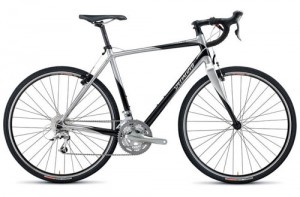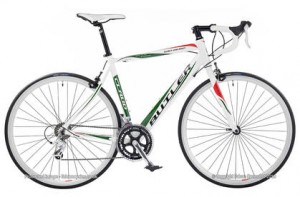A winter training bike is a great luxury to have. You can ride it into the ground and not worry (too much) about your expensive groupset rusting away on salty roads. If things go well, you might spend many hours on your winter training bike, getting in all those winter miles. Make sure it is relatively comfortable as well as practical. For a winter training bike, you can either go for 1) Modifying cheaper road bike 2) more specific touring bike.
My winter training bike is an old road bike, that I used for racing in my first season. It is a basic Aluminium 6061 frame, Carbon fork and Shimano 105 groupset. I bought from Ribble Cycles about 7 years ago, costing around £800. Since then, the bike has done an estimated 20,000 miles – a pretty good return for £800 and minimal upgrades.
Upgrades and Downgrades to Make a Winter Training Bike.
SKS Race blades. The current mudguards are a two year old SKS race blades. They are easy to fit and keep the worst of the rain and mud off. However, if I replaced them, I would go for the SKS race blades long.

Lights Rear and Front. Essential for winter riding. I often leave rear light on flashing whenever it is overcast.
Armadillo Rear Tyre 25‘ This gives confidence for riding through gritty roads. I haven’t had a rear puncture since using this tyre. It is also very hard wearing and very resistant to cuts and scratches. It is slower, heavier and higher rolling resistance, but it is a trade off worth having. Armadillo Tyres
Continental Gator skin Front tyre. The front wheel has a Continental Gator skin. Excellent puncture resistance, though tyre lasts for a shorter time. When I replace, I may replace with Armadillo. (winter training tyres)
Saddle bag. This Altura saddle bag is a little small for my needs. I’d like a bigger saddle bag so that I can carry a weightier waterproof. I currently just have a lightweight race cape. I can carry a waterproof in a cut off water bottle, but often need two bottles for long rides.
Cheaper Cassettes. When replacing cassettes, I’m usually taking bike to local bike shop, so I just ask for cheaper cassettes or chains. I don’t see point in buying Shimano 105 for a winter training bike.
Gearing. I don’t need a triple chain-ring, but I chose a luxury rear cassete with 28 - 12 teeth – offering a nice range of gear choices for keeping high cadence.
How Often do you Change Chain on Winter Training Bike?
On my racing bike, I change chain after 1,000 miles or even shorter (changing chain). This is because I want maximum power transfer from chain. With this method, you can get quite a few chains before the cassette block needs replacing. But, with my winter training bike, I just ride it into the ground; . When the chain starts slipping, which may be up to 4 – 5,000 miles, I will replace chain and cassette at same time, and possibly front chain rings.
How Often do you clean your Winter Training Bike?

Whenever I’m taking pictures of the bike for my blog! I just intended to take photos, but the more photos I took, the more I wanted to clean it.
Perhaps I clean once a month, but when its wet and dirty, it’s too dispiriting to wash after every ride, knowing in 20 minutes, it will be back to the same state. However, some times the dirt build up is so bad, the dirt between brakes and front wheels starts to rub, and I have to knock it off with a stick.
However, I should say – if the road is salty – definitely you should spray off the salty dirt, as it will be very corrosive. For ordinary mud, not so serious, but still worth doing!

The problem with cleaning your winter training bike is that you always fear there must be something bad hidden under all those layers of mud. If you start to clean, somehow you fear it could start to fall apart. This is actually what happened here. Cleaning bike showed paint come off carbon forks.

Position of Winter Training Bike
The position is essentially the same as summer racing bike. The saddle is the same height. I keep the bars slightly higher to make more comfortable for long rides.
Oiling Winter Bike

I regularly spray with GT-80 and also use some winter wet lube – quite a heavy oil. I also spray and grease my Speedplay pedals in winter.
Winter Training Bikes
When I bought a top of the range road bike, one justification was that I was also getting a free winter training bike. But, if started at the top, and want to buy a specific winter training bike there are quite a few options.
Specialized Tri Cross

A lightweight A1 Premium Aluminium double butted frame. Comfortable frame geometry, internal cable routing for low maintenance performance in any conditions. FACT carbon forks for improved comfort of ride. Triple chain ring for all gear combinations
- Specialized TriCross £700 at Evans
Under £500
Claud Butler San Remo £499
A budget bike leaving some cash left over for necessary winter accessories. The Claud Butler San Remo is aluminium frame, steel forks and Shimano 23000 groupset. Claud Butler at Evans Cycles
Other bikes to consider – Trek 1.2, 1.7 or 2.1. Focus Cayo.
See also:



Hi Tejvan,
I use a steel-framed Falcon I bought 21 years ago as a winter bike – big & heavy, ideal for working up a sweat on a cold winter day. Tyres are 25mm Conti Gatorskins and the transmission has a Shimano 7-speed block – as a result this and the chain are inexpensive enough to replace.
The only bugbear is the chainrings are an old size (122mm BCD) and difficult to find. To extend their life I keep a regular check on chainwear and scrap the chain at 0.75% wear – approx every 1200 to 1500 miles.
Incidentally, the bike gets washed weekly – I don’t want to turn up to the Sunday club ride on a filthy bike – apart from the issue of pride, cleaning the bike means inspecting it regularly and sorting out any minor problems before they become big problems …